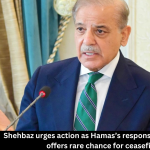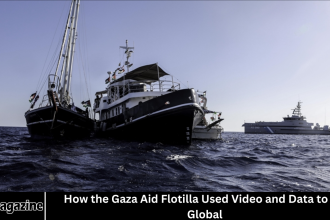In a conflict marked by profound human suffering and stalled diplomacy, a glimmer of hope has emerged. Hamas’s formal response to a US-backed ceasefire proposal has been met with cautious optimism by world leaders, who recognize it as a potential turning point in the nine-month-long war in Gaza.
- The US-Backed Ceasefire Plan: A Three-Phase Roadmap
- Phase One: A 42-Day Halt and Hostage-Prisoner Exchange
- Phase Two: A Permanent End to Hostilities
- Phase Three: Gaza’s Reconstruction
- Decoding Hamas’s Response: Qualified Acceptance and Core Reservations
- Shehbaz Sharif’s Urgent Call: A Voice for the Global South
- The International and Regional Chessboard
- The Road Ahead: From Ceasefire to a Lasting Peace
- Frequently Asked Question
- What is the “rare chance” that Prime Minister Shehbaz Sharif is referring to?
- What are the key points of the three-phase ceasefire plan?
- Did Hamas fully accept the ceasefire proposal?
- Why is PM Shehbaz Sharif so involved in this issue?
- What is the main obstacle to finalizing a deal?
- What happens if a temporary ceasefire is achieved?
- What is the “Day After” problem?
- Conclusion
Among the most vocal voices is Pakistani Prime Minister Shehbaz Sharif, who has issued a urgent call to the international community, framing this moment as a “rare chance” that must not be squandered.
This development is not just another headline in a long-running tragedy; it represents the most significant diplomatic opening in months, carrying the potential to halt the violence, facilitate a massive humanitarian intervention, and begin a precarious journey toward a more stable future.
More Read: Lose Weight with a 30-Day High-Protein Breakfast Challenge
The US-Backed Ceasefire Plan: A Three-Phase Roadmap
The proposal at the heart of these negotiations is a detailed three-phase plan, initially outlined by US President Joe Biden in late May and later formally adopted by the UN Security Council. Its structured approach is designed to create a step-by-step de-escalation.
Phase One: A 42-Day Halt and Hostage-Prisoner Exchange
The first and most critical phase would see an immediate, six-week ceasefire. During this period:
-
Cessation of Hostilities: Israeli forces would withdraw from populated areas in Gaza.
-
Hostage and Prisoner Release: Hamas would release elderly, women, and sick hostages in exchange for a large number of Palestinian prisoners held in Israeli jails.
-
Humanitarian Surge: A significant increase in humanitarian aid would be allowed into Gaza, where the population faces widespread famine and a collapsed healthcare system. This includes the safe and unhindered distribution of food, medicine, fuel, and shelter materials across the entire Strip.
Phase Two: A Permanent End to Hostilities
This phase is contingent on the successful implementation of Phase One. It envisions:
-
The release of all remaining living Israeli hostages, including male soldiers.
-
A full withdrawal of Israeli forces from Gaza.
-
The crucial and most contentious element: negotiations for a “permanent cessation of military and hostile activities.”
Phase Three: Gaza’s Reconstruction
The final phase would be a multi-year plan focused on:
-
The reconstruction of Gaza’s utterly devastated infrastructure, including homes, hospitals, schools, and water systems.
-
The return of the remains of deceased hostages.
-
A long-term framework for governance and security in Gaza, a topic of intense international debate.
Decoding Hamas’s Response: Qualified Acceptance and Core Reservations
Hamas’s official response to this plan was not a simple “yes” or “no.” It was a detailed document that mediators described as a “positive signal,” but one laden with reservations and proposed amendments. Understanding their position is key to gauging the proposal’s viability.
What Hamas Accepted:
Hamas has, in principle, agreed to the core structure of the plan, particularly the initial six-week ceasefire and the hostage-prisoner exchange.
This is a significant shift from their previous positions and indicates a serious desire to de-escalate, likely driven by the catastrophic humanitarian conditions in Gaza and immense pressure from their own population.
Key Points of Contention:
Hamas’s primary demand is a cast-iron guarantee that the process will lead to a permanent ceasefire and a full Israeli withdrawal.
They are wary of a repeat of previous conflicts where temporary truces collapsed, leaving Israel in military control. Their specific reservations include:
-
Sequencing and Guarantees: They seek assurances that Phase Two will definitively commence, preventing Israel from resuming operations after the initial hostage release.
-
The “Day After” and Israeli Veto Power: Hamas has rejected Israel’s insistence on having a veto over which Palestinian figures would govern Gaza in a post-war scenario. They view this as an infringement on Palestinian sovereignty and a mechanism for Israel to maintain indirect control.
-
The Withdrawal Timeline: Clarifications are sought on the exact timeline and scope of the Israeli military withdrawal during the first phase.
In essence, Hamas is using its response to call the international community’s bluff, demanding that the proposed roadmap leads to a definitive end to the war, not just a temporary pause.
Shehbaz Sharif’s Urgent Call: A Voice for the Global South
Against this backdrop, Pakistani Prime Minister Shehbaz Sharif has emerged as a prominent advocate for seizing this diplomatic opening.
His statements, made both bilaterally and in multilateral forums, carry weight due to Pakistan’s status as a major Muslim-majority nation, a nuclear power, and a traditional supporter of the Palestinian cause.
The Substance of His Appeal:
PM Shehbaz’s rhetoric has been deliberate and strategic. He has:
-
Framed it as a “Rare Chance”: By using this language, he emphasizes the fragility and uniqueness of the moment, urging world powers not to let it slip away due to procedural delays or maximalist demands.
-
Called for Concrete Action: He has moved beyond mere statements of concern, explicitly urging the United States, the United Nations, and Arab leaders to “persuade” and “press” Israel to engage seriously with Hamas’s response. He has called for the UN Security Council to ensure the implementation of its own resolution.
-
Highlighted the Humanitarian Catastrophe: In all his addresses, he has consistently foregrounded the immense human cost of the war—the over 37,000 Palestinian deaths, the children suffering from malnutrition, and the wholesale destruction. This aligns the diplomatic process with the urgent moral imperative to save lives.
-
Represented a Broader Consensus: PM Shehbaz’s position reflects the view of the Organization of Islamic Cooperation (OIC) and much of the Global South, which sees the war in Gaza as a symptom of a prolonged injustice and the international community’s failure to uphold Palestinian rights.
His advocacy is not just about this single ceasefire but about reinvigorating a dormant peace process and restoring credibility to international law and institutions.
The International and Regional Chessboard
The response to Hamas’s counterproposal has created a complex diplomatic landscape, with various actors maneuvering for influence.
-
United States: The Biden administration is in a delicate position. It is publicly pushing for the deal it helped craft, pressuring Hamas to fully accept the terms while also urging Israel to show flexibility. Domestically, the administration faces pressure from within its own party to end the war and secure the release of hostages.
-
Qatar and Egypt: As the primary mediators, with decades-long channels of communication with Hamas, Qatar and Egypt are working tirelessly to bridge the gaps between the two sides. They are instrumental in interpreting Hamas’s response and shuttling messages back and forth.
-
Israel: The Israeli government, led by Prime Minister Benjamin Netanyahu, is deeply divided. His far-right coalition partners have threatened to collapse the government if he agrees to a deal that ends the war without achieving the stated goal of “destroying Hamas.” This internal political pressure is a major obstacle. The Israeli response to Hamas’s amendments has been cautious, with officials stating there are “gaps” that need to be addressed.
-
United Nations and EU: These bodies have universally welcomed the proposal and are pushing for its unconditional implementation, framing it as the best and only way to address the humanitarian emergency.
The Road Ahead: From Ceasefire to a Lasting Peace
Even if a temporary ceasefire is secured, the path to a sustainable peace is fraught with challenges.
1. The “Day After” Problem: The most significant long-term question remains unanswered: who will govern Gaza? Israel refuses a return of the Palestinian Authority (PA) without reforms, and vehemently rejects a continued role for Hamas.
Hamas, in turn, seeks a role in a future governance structure. The US has proposed a reformed PA with international support, but details are scarce. This governance vacuum is a recipe for future instability.
2. Disarming Hamas vs. Political Integration: The Israeli war cabinet’s stated goal of eradicating Hamas militarily and politically appears increasingly unattainable.
A more realistic, though highly contentious, solution may involve some form of political integration of Hamas into a broader Palestinian governing body in exchange for disarmament—a scenario neither Israel nor Hamas is currently prepared to accept.
3. The Reconstruction Quandary: Rebuilding Gaza will cost tens of billions of dollars. The international community is unlikely to fund reconstruction without a credible, legitimate Palestinian government in place and a clear political horizon for a two-state solution.
Donors will not pay to rebuild Gaza only for it to be destroyed in another cycle of violence.
4. Reviving the Two-State Solution: Ultimately, a lasting peace requires addressing the root cause of the conflict. The war in Gaza has brutally exposed the failure of the Oslo Accords and the stagnation of the two-state solution.
Any viable long-term plan must include a serious, time-bound, and internationally backed process to create a sovereign Palestinian state alongside Israel. Without this political horizon, any ceasefire will be merely an intermission between wars.
Frequently Asked Question
What is the “rare chance” that Prime Minister Shehbaz Sharif is referring to?
The “rare chance” is a critical diplomatic opening created by Hamas’s formal response to a US-backed, three-phase ceasefire proposal. After months of war with little progress in negotiations, Hamas’s engagement with the plan is seen as the most significant opportunity in recent memory to secure a truce, facilitate a massive surge in humanitarian aid, and begin a process that could lead to a more permanent end to the hostilities.
What are the key points of the three-phase ceasefire plan?
Phase One: A six-week ceasefire with a withdrawal of Israeli forces from populated areas in Gaza, an initial exchange of Israeli hostages (women, elderly, sick) for Palestinian prisoners, and a major increase in humanitarian aid.
- Phase Two: The release of all remaining living hostages, a full Israeli military withdrawal from Gaza, and the negotiation of a “permanent cessation of hostilities.”
- Phase Three: A multi-year plan to rebuild Gaza’s devastated infrastructure and the return of deceased hostages’ remains.
Did Hamas fully accept the ceasefire proposal?
No, not fully. Hamas provided a response with “qualified acceptance.” They have agreed to the plan’s core structure in principle but have submitted reservations and requested amendments. Their primary demand is a guaranteed pathway to a permanent ceasefire and a full Israeli withdrawal, wanting assurances that Israel cannot resume the war after the first phase.
Why is PM Shehbaz Sharif so involved in this issue?
As the leader of a major Muslim-majority nation and a traditional supporter of the Palestinian cause, PM Shehbaz is using Pakistan’s diplomatic voice to:
- Represent the consensus of the Organization of Islamic Cooperation (OIC) and the Global South.
- Urge powerful nations like the US to pressure Israel to engage seriously with the proposal.
- Highlight the catastrophic humanitarian situation and the moral imperative to act.
- Ensure this diplomatic window is not lost due to political delays.
What is the main obstacle to finalizing a deal?
The main obstacle is a combination of political divisions within Israel and differing end-game demands.
In Israel, Prime Minister Netanyahu’s coalition relies on far-right partners who have threatened to collapse the government if he agrees to a deal that ends the war without “destroying Hamas.”
On the substantive side, Hamas wants a guaranteed permanent ceasefire, while the current Israeli government is resistant to committing to a full and permanent end to operations.
What happens if a temporary ceasefire is achieved?
A temporary ceasefire would be a monumental first step, allowing for:
- A crucial pause in fighting to deliver life-saving aid across Gaza.
- The release of hostages and prisoners, reuniting them with families.
- A temporary respite for civilians on both sides.
However, the larger challenges of the “day after” would remain, including who governs Gaza, disarming militant groups, and initiating a credible political process for a long-term solution.
What is the “Day After” problem?
This is the critical, unresolved question of who will govern Gaza after the war. Israel rejects a role for Hamas and is skeptical of the current Palestinian Authority (PA). Hamas seeks a role in a future government. The international community is reluctant to fund reconstruction without a credible, legitimate Palestinian governing body in place. This governance vacuum is a major risk factor for future instability and conflict, even if a temporary truce is secured.
Conclusion
The response from Hamas to the Gaza ceasefire plan has, against all odds, created a palpable sense of possibility. It is a rare and fragile chance to stop the bleeding, feed the starving, and reunite families torn apart by war.
Prime Minister Shehbaz Sharif’s urgent call to action echoes the sentiments of millions around the world who are watching in horror and demanding an end to the violence.















